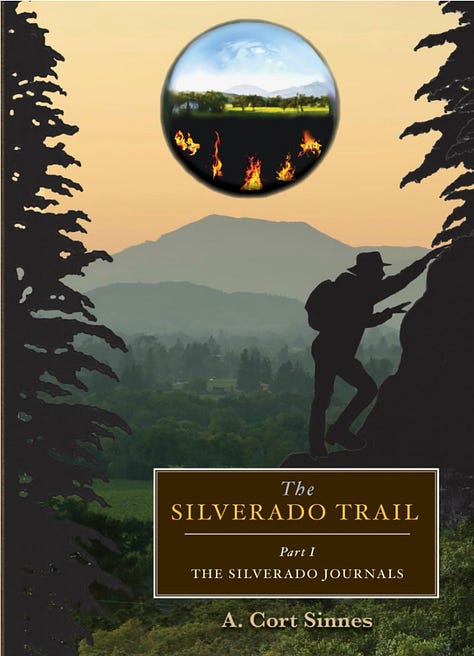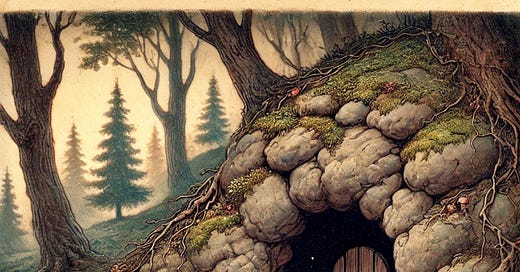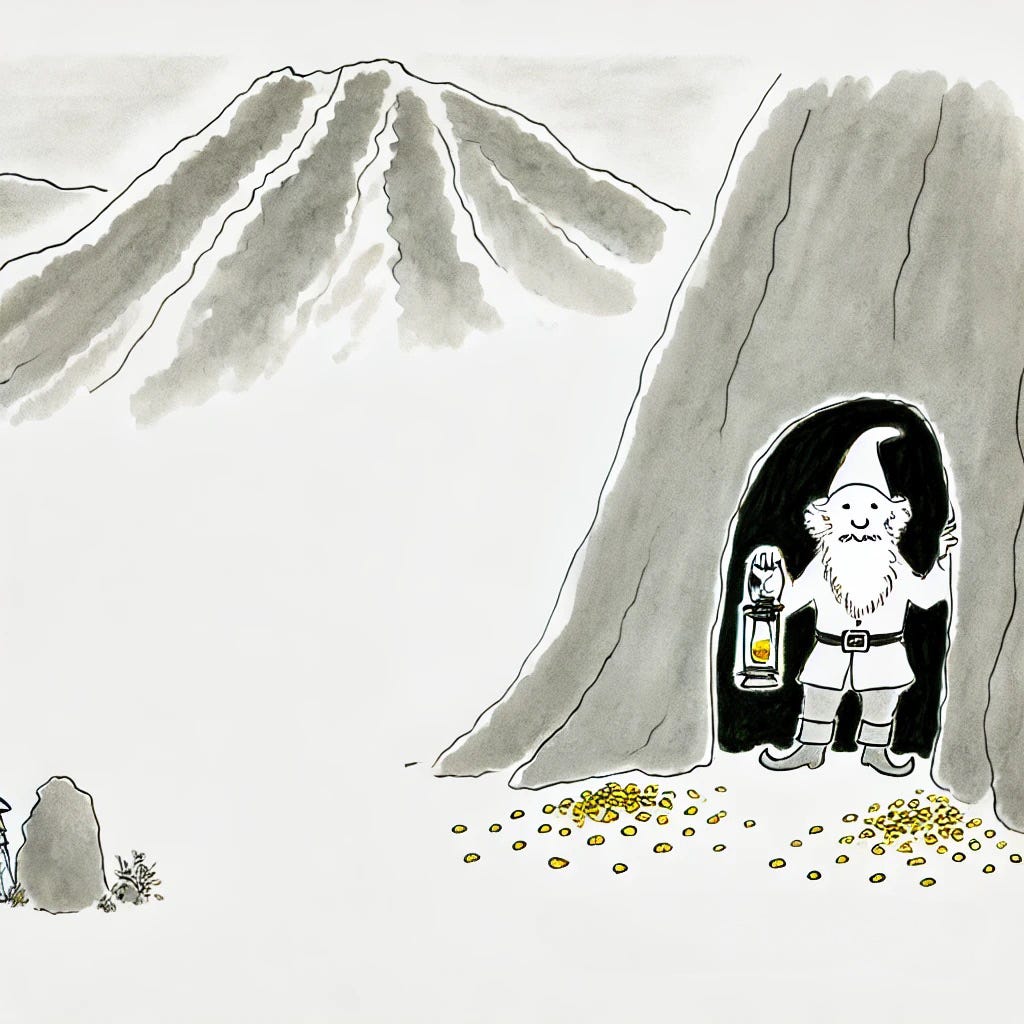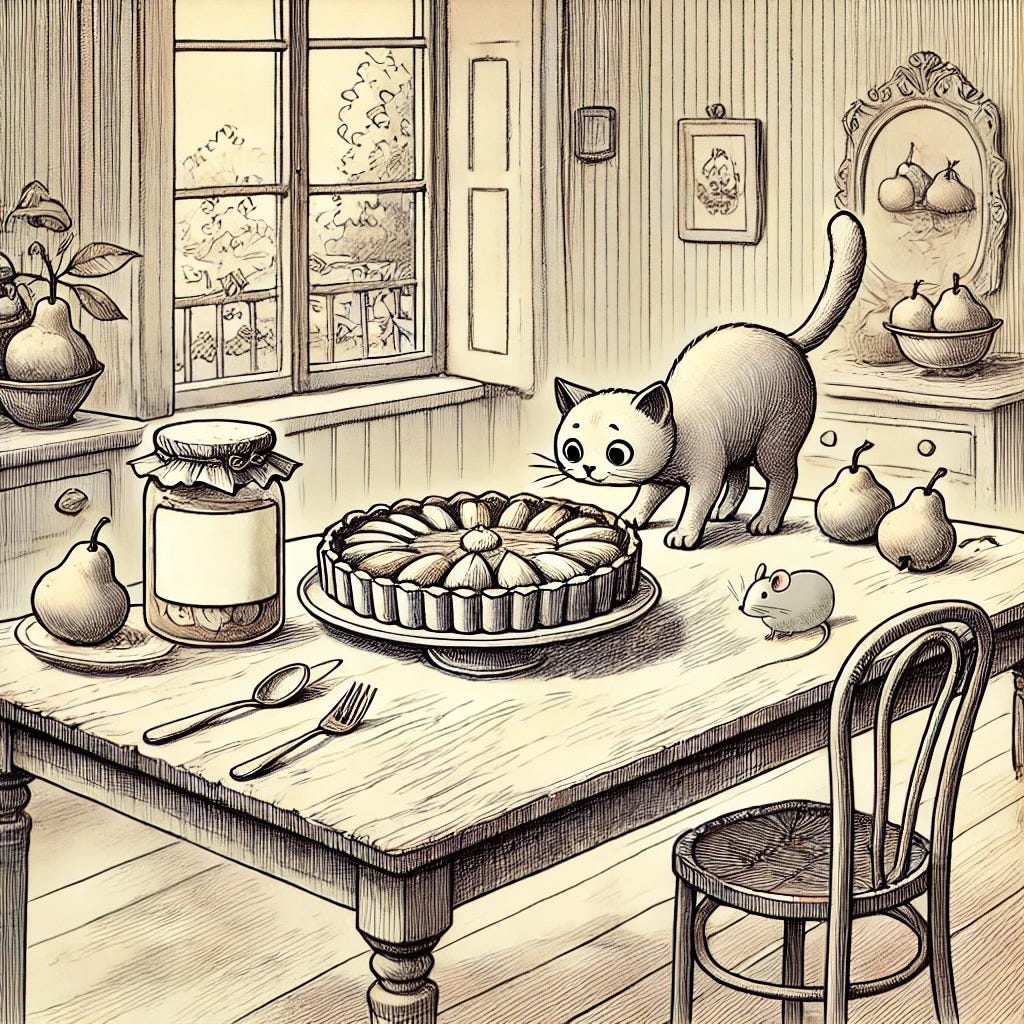Before we step into Sasha Paulsen’s tale of gnomes on Mount St. Helena, here’s a reminder: Napa Valley Features is a reader-funded publication. Without support from new and returning subscribers, stories like these could become fewer, or we might be forced to close altogether. If you enjoy our ad-free, independent local reporting, please consider becoming a paid subscriber. For as little as 16 cents a day, you can help keep stories like this alive and vibrant.
NAPA VALLEY, Calif. — Every mountain holds its secrets — so 14-year-old Nick Sinclair discovers in the summer of 1967 when he sets out to solve a mystery of a missing pony and a bag of gold.
He records his discoveries in a journal. (“Private Journal — Keep Out! This means you!”) Decades later, his grandson, Joachin, reads “Quicksilver, An Account of the Fantastic Events of the Summer of 1967” and can’t decide if his artist-writer grandad has a too-active imagination or is just off his rocker altogether.
But that’s only until Joachin, too, meets the gnomes who live on Mount St. Helena.
So begins “The Silverado Journals,” a rollicking trilogy that is a magical mix of whimsy and wonder, fantasy and farm chores sprinkled with enchanting artwork from local author and artist A. Cort Sinnes.
The gnomes, like all immigrants to America, were in search of a better life, or in their case a refuge from unfriendly ‘uplanders’ — tall people — who kept annoying them by ringing church bells near their caves.
Book 1, “The Silverado Trail,” introduces Nick, an orphan living with foster parents on the Twin Oaks Pony Farm in St. Helena, by way of his journal, which the skeptical Joachin is reading. All the while he is quizzing his grandfather: Did you make all of this up?
This is Nick’s tale: When the farm’s prize pony, Quicksilver, disappears one night, Nick sets out to find him, a challenge that involves trips to the St. Helena Library and the county sheriff’s office.
It’s Nick’s patrician grandmother who provides the final clues. She lives in San Francisco but also spends time at a house in St. Helena, which she inherited from her adopted father, a Finnish sea captain. It’s this captain, Nick learns, who brought the gnomes to the valley in 1901, when they stowed away on his ship en route from Finland to California.
The gnomes, like all immigrants to America, were in search of a better life, or in their case a refuge from unfriendly “uplanders” — tall people — who kept annoying them by ringing church bells near their caves.
The captain cut a deal, passage to the New World for them and their considerable stash of gold if they would use their cave-digging skills for a winery he was planning to build in a quiet little valley where grapes seemed to thrive. After upholding their side of the bargain, the gnomes disappeared but found a comfortable new home in a gold-lined cave on Mount St. Helena, out of sight of any uplanders. They lived happily hidden and largely self-sufficient, but when they needed something they couldn’t contrive, they quietly appropriated it, always leaving payment in the form of gold nuggets.
In 1967, they needed a pony for their King Gob.
Nick’s adventures include outwitting an unscrupulous journalist out to break the story and expose the gnomes, but with the help of a hermit on the mountain he finds Quicksilver. After being captured by the gnomes, he and his grandmother rekindle the bond of friendship with a feast of Chinese takeout from Golden Harvest.



Book II, “The Voyage of the Silverado,” continues with the journal, now from 1968, when Nick and friends undertake a new quest. It seems that en route to California five gnomes jumped ship at a stop in Kauai because they were tired of being seasick. One of these gnomes was their wizard, Dagwyn.
A wizard, it transpires, is even more important than the king because in addition to their many magical powers — living almost forever, digging caves — each gnome possesses one special gift, such as levitation. The wizard, however, has them all.
King Gob has decided that after a 68-year vacation in Kauai, it’s time for Dagwyn to return to the gnome fold. And he is sure that Nick is the one to accomplish this feat.
In Book III, “Escape to Silverado,” Joachin joins the action when King Gob has a new project for his now old friend, Nick. He would like Nick and Joachin to travel to Finland and find his wife, who opted to stay behind with other gnomes when the king and his band set out to find a new home. King Gob is sure that Nick and Joaquin are the ones to persuade his wife and the others to join him on the mountain in Napa Valley.
By this point, the bothersome journalist is history, but the grandfather and grandson have a new adversary to confront: Bad Boris from Volsakia, whose gang is after the gnomes’ gold.
The sum of all these globe-trotting escapades is pure delight, an adroit mixing of real and make-believe. Or is it make-believe? As anyone who has tried to write fiction will tell you, a story is a strange combination of real and imaginary events and people who somehow recombine themselves inside a writer’s head.
“This story contains many things that actually happened, some of them quite strange,” Sinnes writes in an afterword.
Perhaps, he muses, it all began with a message he received in a fortune cookie: “A legacy, no matter how obscure, will soon be yours.”
Certainly part of it was inspired by Sinnes’ own grandfather, a Finnish sea captain like Gustave Niebaum from the book.
Captain Nels Sinnes also discovered stowaways on his ship when it landed in Hawaii, although they were two teenage boys, not gnomes. Sinnes, however, was so fascinated with his grandfather’s memorabilia and asked so many questions that his grandfather gave him a ship’s log to read.
While I was standing there, taking in the sight, the entire story contained in ‘The Silverado Journals’ — beginning, middle and end — in great detail, was deposited in my brain. Where it came from, I guess I’ll never know.
When he was 18, Sinnes went to Finland with his grandparents, who wanted him to learn about the culture of his heritage. This resulted in a 400-mile road trip to Lapland. In an afterword, he writes, “I think it’s safe to say that, right at that moment, I was the only 18-year-old American driving his grandparents from Helsinki, Finland, to Rovaniemi, Lapland, which only enhanced the out-of-this world experience.”
Then, in 1980, he was on a family vacation on Kauai with his wife and year-old daughter, who was teething and not sleeping well except when she was riding in a car. He and his wife devised a schedule, taking turns driving her so that the other parent could have a break. On one of his turns, Sinnes stopped at a historical marker that explained that he was looking at the Alikoko (Menehune) Fishpond, which, legend says, “was built by the Menehune.”


The Menehune, according to folklore, are a race of dwarflike people from Hawaii.
“While I was standing there, taking in the sight, the entire story contained in ‘The Silverado Journals’ — beginning, middle and end — in great detail, was deposited in my brain,” Sinnes writes. “Where it came from, I guess I’ll never know.”
And back in St. Helena, in 1986, he was working on his Silverado stories when he opened the St. Helena Star and read a headline: “27-inch Tall Horse Stolen in St. Helena.”
“The world works in mysterious ways,” Sinnes observes. “Not everyone will care to believe the ‘facts’ that come to light in this book. As for me, I believe it all.”
If you, like the gnomes, find yourself in need of an escape, however temporary, you might need to look no farther than the mountain in our backyard.
Check local bookstores, The Bookmine in Napa, and Copperfield’s in Calistoga and Napa for copies of “The Silverado Trilogy.”
If today’s story captured your interest, explore these related articles:
Sunday E-dition: Rediscovering Quince, California's Forgotten Fall Fruit
Sunday E-dition: Paws for Peace Supports Domestic Violence Survivors
Sunday E-dition: Napa's Haunting Spirits — A Ghostly Trilogy
Sunday E-dition: Calistoga and Its Library – a Century Long Retrospective
The Historical (And Personal) Significance of Mexican Independence Day
Sasha Paulsen is a Napa Valley-based novelist and journalist.
Levity Corner
Caption contest: Pick your favorite caption or add your own in the comments below.
Possible captions:
“It’s a quiet life, but somebody’s gotta do it.”
"They say not all that glitters is gold, but I’m not taking chances.”
“The secret to happiness: a quiet cave and no WiFi.”
“They call it a hidden treasure, but I call it Tuesday.”
“Welcome to my TED Talk: ‘Hoarding or Self-Care? You decide.”
Last week’s contest results
In “Sunday E-dition: Rediscovering Quince, California's Forgotten Fall Fruit,” the winning caption was, “You distract her, and I’ll go in for the tart,” with 32% of the votes.
"Just one nibble… they’ll never notice."
"Temptation comes in many forms…”
"They never said curiosity wouldn’t get you dessert."
"You distract her, and I’ll go in for the tart."
"Two adversaries. One tart. Infinite possibilities."
Last Week
In "Rediscovering Quince, California's Forgotten Fall Fruit," Georgeanne Brennan shared her journey with quince, a historic but underused fruit she first encountered in France and later cultivated in her own California yard. Brennan described how she and other local chefs such as Taylor Boetticher creatively use quince in dishes such as tarte tatin, membrillo and quince-stuffed pork. Despite its culinary versatility, quince remains uncommon on restaurant menus, which Brennan hopes might change as chefs experiment with its rich flavors and textures.
In "Is it Time for a Habitat Conservation Plan?" Yvonne Baginski reported on rapid development in South Napa County, where open spaces are being rezoned and built upon, threatening habitats for local wildlife. With no private land in the area designated for conservation, projects such as business parks and warehouses displace species like the Swainson’s hawk, while Napa’s cumulative environmental impact remains unaddressed. Baginski highlighted examples of Habitat Conservation Plans used in other California counties, which balance development with conservation by mapping entire bioregions to protect at-risk species. She called for Napa County to adopt similar measures and invited public engagement in local conservation efforts.
In "Zinfandel’s True Worth," Dan Berger reflected on his underestimation of zinfandel in a previous column after Napa wine expert Mike Rubin reminded him of the grape’s complexity and heritage. Berger discussed how many producers overconcentrate the grape, sacrificing its delicate flavors for heavy, high-alcohol wines. He also traced zinfandel’s lineage, including its Croatian origins as crljenak kaštelanski and issues with the grape’s regulatory classification. Highlighting diverse styles of zinfandel, from elegant reds to dessert wines, Berger praised producers like Frog’s Leap and Carol Shelton for preserving zinfandel’s true character.
In "Integrated Pest Management Can Help Keep Your Garden Safe," Penny Pawl explained the principles of Integrated Pest Management, a pest-control approach that minimizes chemical use by promoting natural pest predators and sustainable practices. Pawl described her own challenges with pests, from aphids on milkweed to gophers and moles, and how IPM strategies have helped her manage these issues more effectively. She also highlighted the destructive Mediterranean fruit fly, an invasive species in California, and shared how it’s managed through the release of sterile males. Pawl encouraged readers to explore IPM resources and reach out to the local Master Gardener Help Desk for support.
In "Cook St. Helena Celebrates 20 Years of Local Flavor and Resilience," Tim Carl recounted the recent 20th anniversary celebration for Cook St. Helena, a local favorite restaurant known for its simple, heartfelt approach to dining. Founded by Jude Wilmoth with the goal of creating a welcoming space for locals, Cook has weathered challenges, including the pandemic and the 2020 Glass Fire that destroyed his home. With dishes such as fresh pasta and gnocchi, Cook remains a beloved gathering spot that prioritizes community over luxury in Napa Valley's high-end dining scene. As Cook looks to the future, it remains committed to its roots as a local mainstay for friends, family and familiar faces.
Next Week
Next week we have more engaging articles from Napa Valley Features contributors. The UC Master Gardeners of Napa County will offer tips for “Green Wednesday” while Dan Berger will share his newest pick from Napa Valley wines. Tim Carl will explore free pest-control services throughout Napa County. Dave Stoneberg will spotlight a new artist exhibit, and readers will also discover surprising facts about local birds and much more.








Hi Tim, thank you for the article, I will look for the book at Bookmines as our family has also thought highly of Gnomes.
I am reading an interesting book now, Napa Valley Historical Ecology Atlas by Robin Grossinger.
Have a nice Thanksgiving
Bruce
As a history fan, I would also like to read stories based on history and the real history of the Napa Valley. I wanted to "click" that box, too.